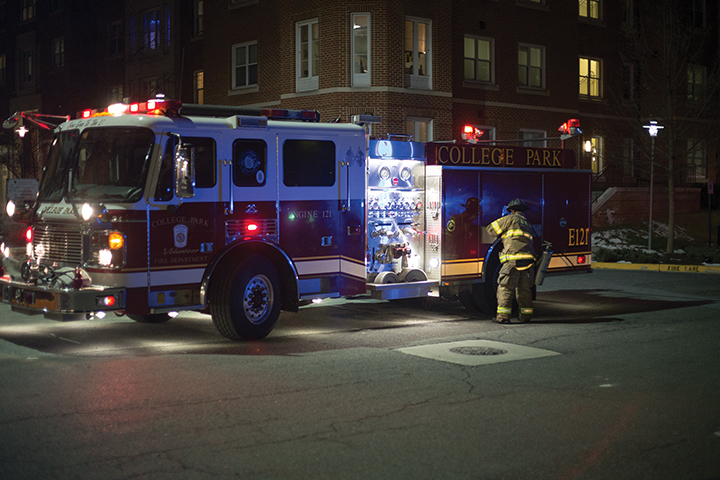
A firetruck responded to a fire in South Campus Commons 1 last month. Facilities Management officials will replace alarms and sprinklers in 11 campus facilities. The cost of planned fire prevention system upgrades range from $80,000 to $350,000.
Starting this year, campus academic buildings will receive new fire alarms and sprinklers capable of providing firefighters with more specific information about a fire’s location, Facilities Management officials said.
“There was nothing wrong with the old systems,” said Jack Baker, Facilities Management operations and maintenance director. “It’s sort of like a personal computer; every few years the technology changes for the better.”
Workers are modernizing fire prevention systems in 11 facilities, focusing primarily on buildings where lectures and classes are held, such as H.J. Patterson Hall, the Mathematics Building and the Potomac Building, Baker said.
Facilities Management will update more buildings each year through 2025. The cost of the upgrades will range from $80,000 for new fire alarms in the Potomac Building $350,000 for updated sprinklers in the Mathematics Building, according to the “Invisible Crisis” document, which outlines the university’s plans to update campus infrastructure.
Facilities Management will replace the older sirens and alarm pulleys with newer, more compatible ones and overhaul control panels to specifically locate fires.
“In the old days, if there was a fire, you wouldn’t know where it was in the building until you the saw the actual flame,” Baker said.
Once the new smoke detectors identify a fire, they directly send details of the blaze’s location to the alarm system and fire departments.
“It makes it much easier to direct people away from possibly dangerous areas and makes fighting fires easier in complicated buildings,” said James Milke, university professor and fire protection engineering department chairman.
Addressable alarms date back to the 1980s, Milke said. But the university has not yet upgraded the alarms in academic buildings because its main focus was to ensure safety in student living spaces before tackling classrooms, which still have alarm systems that are up to code, Baker said.
Alan Sactor, university fire marshal and the environmental safety department’s assistant director, said fire alarm systems have a long life, and while addressable alarm systems are more advanced, older systems are just as safe and effective.
“Fire systems are designed for reliability,” he said. “You don’t need to update them immediately.”
The academic building updates are the last steps in a long-term effort to update fire protection on the campus, Baker said. All dorms and Fraternity Row houses have received addressable fire systems and updated devices similar to those being added now, said Andrew Van Der Stuyf, Residential Facilities assistant director.
Fire alarms aren’t the only updates; Facilities Management workers continue to modernize much of the school’s aging infrastructure. The “Invisible Crisis” outlines 122 projects and 13 years of changes to the university’s pipes, heating and cooling systems and fire protection systems, which are becoming too outdated to be fully functional, according to the plan.



